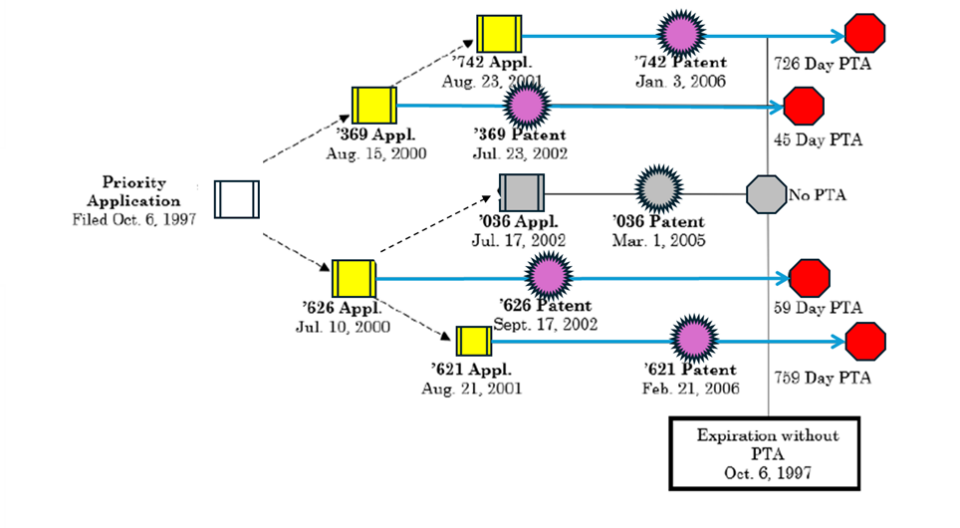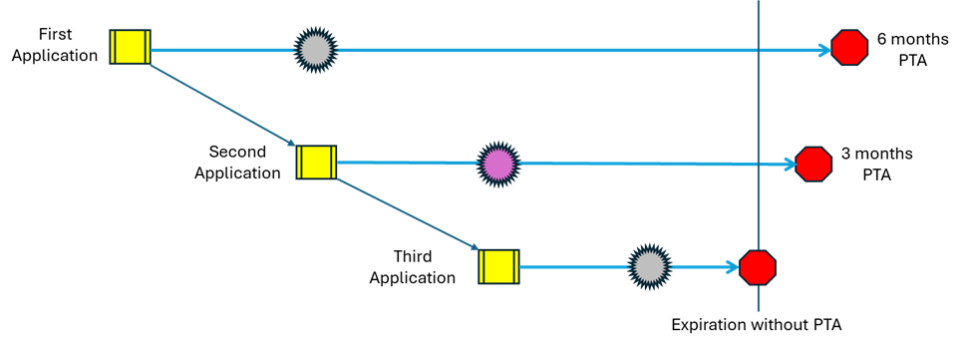When a patent application is allowed, the claims may not precisely cover everything that the applicant wants to protect. Rather than add new claims after a notice of allowance and prolong prosecution, applicants will commonly file one or more continuation applications to pursue different claims. The continuation has substantially the same specification and drawings as the original application and will claim priority to the original application, so it is treated as having the same filing date and – absent any adjustments due to patent office delay – the same expiration date as the original. But when such patents have different adjustments to their term, troubles may arise. The Federal Circuit’s most recent decision on this issue addresses some, but not all, potentially problematic situations, as we explain here.
An Example
Let’s imagine a scenario where you’ve invented a “widget” and file a patent application that describes different types of widgets. After a lengthy patent prosecution, including some delays by the USPTO, the patent ultimately issues with claims that only cover red widgets. Because of the USPTO’s delays, the patent receives a patent term adjustment, i.e., an extension of the time until it expires.
Before the original application issues, you decide that you also want claims that cover blue widgets, so you file a continuation application. The Examiner issues an obvious-type double patenting rejection based on the first patent, because the blue widgets are an obvious variation of the red widgets. To overcome this rejection, you file a terminal disclaimer, which means the term of the new patent will not be longer than the term of the first patent. After that, the continuation application sails through the USPTO without delay and issues without any adjustment to its term.
You never file a terminal disclaimer in the first patent—why would you? So, the timeline of the two patents looks like this:

You now own two patents covering similar subject matter that have different expiration dates. Is this okay? How comfortable should you be about your patent rights if you want to file a patent infringement lawsuit against a competitor making red widgets or blue widgets?
The Policy in Play
To answer that, we need to understand the policy rationales at play. The U.S. government is balancing a few competing interests when it comes to patent term adjustments and continuations. First, because a patent expires 20 years from the date that the application was filed, the government doesn’t want to penalize a patentee for delays that were caused by the USPTO. However, it also wants to protect the public by guarding against an extension of patent rights beyond the term the patentee is entitled to.
To address the first concern, the USPTO must grant a Patent Term Adjustment (“PTA”) at the time the patent issues if it responsible for undue delays in issuance of the patent. 35 USC § 154 imposes several different deadlines on the USPTO for prosecuting patent applications. If the USPTO fails to meet those deadlines, the patent term is extended by one day for every day the USPTO is late. The patent term will not be extended, however, for any delays attributed to the Applicant.
To address the second concern, the USPTO will require a patent applicant to file a terminal disclaimer if the claims of a continuation are merely an obvious variation of the claims of another commonly-owned application. This prevents an improper extension of patent term. The terminal disclaimer is a simple, boilerplate form that can be downloaded from the USPTO website.
In two different opinions in the past year, the Federal Circuit has grappled with how to treat a family of patents that have different expiration dates. The Federal Circuit considered these policy considerations as well as the relevant statutory language.
In re Cellect
In August 2023, Circuit Judges Lourie, Dyk, and Reyna looked at a family of patents with different expirations in In re Cellect. Cellect, LLC had sued Samsung, accusing it of infringing four different patents (identified by purple symbols below). Samsung then filed requests for ex parte reexamination at the USPTO for each patent, which the USPTO granted. Each of the four patents claimed priority to the same original patent application (shown on the far left below), which was not part of the lawsuit or the reexaminations. Additionally, there was one other patent in the family—the ‘036 patent (shown by grey symbol below)—that was not part of the lawsuit or the reexaminations. The ‘036 patent was the last patent application in the family to be filed. It did not receive any PTA. By contrast, the four challenged patents all received PTA of varying lengths. No terminal disclaimers were filed in the challenged patents. The details are shown in the following family tree:

During the reexamination, the Examiner found each of the challenged patents was unpatentable under the doctrine of obvious-type double patenting. Each double patenting rejection could be traced to the ‘036 patent. Unfortunately for Cellect, all of the challenged patents had expired by this point of the reexamination, so Cellect could no longer file terminal disclaimers. The Examiner thus found all four challenged patents to be unpatentable. The Patent Trial and Appeal Board (“PTAB”) affirmed the Examiner.
On further appeal, the Federal Circuit noted that the purpose of obvious-type double patenting is to prevent an inventor from securing a second, later-expiring patent for non-distinct claims. It found that “Cellect had the opportunity to file terminal disclaimers in this case during both prosecution and ex parte reexamination.” It noted, however, that “[n]o terminal disclaimers were filed by Cellect, and the patents at issue have all expired, precluding any late filings of terminal disclaimers.” It thus concluded that Cellect received an unjustified extension of the challenged patents, and unanimously affirmed the PTAB.
Revisiting In re Cellect
One year later, Circuit Judges Lourie, Dyk, and Reyna (the same three judges from In re Cellect!) looked at a similar issue in Allergan USA v. MSN Laboratories and came to a different conclusion. This time, the first-filed, first-issued patent of a family was asserted in a patent litigation. That patent had been granted PTA of 467 days. Two continuations were also filed, but were not granted any PTA. Those two continuations were not part of the litigation. No terminal disclaimers had been filed in the first-filed patent. The family tree looked like this:

The district court found that the first-filed patent was invalid, based on obvious-type double patenting, citing In re Cellect. But on appeal, the Federal Circuit said that “Cellect cannot be read as ‘confirming,’ much less holding, that a later-filed, later-issued, earlier expiring claim is a proper [obvious-type double patenting] reference against a first-filed, first-issued, later expiring claim having a common priority date.” It faulted the parties in Cellect for failing to raise the issue of whether a later-filed patent was a proper obvious-type double patenting
reference against an earlier-filed patent.
This time, the Federal Circuit observed, “the purpose of the [obvious-type double patenting] doctrine … is to prevent patentees from obtaining a second patent on a patentably indistinct invention to effectively extend the life of a first patent to that subject matter.” It reasoned that a parent cannot “be said to result in an extension of patent term of the invention claimed in the child patent when, as here, the claims in the child patent did not even exist until after the parent patent issued.” It also stated that it would be “untenable” for a patentee to disclaim the benefit of congressionally guaranteed patent term on its first patent based on the prosecution of later patent application.
The Federal Circuit therefore concluded that “the first filed, first issued patent in its family … sets the maximum period of exclusivity for the claimed subject matter and any patentably indistinct variants.”
The Implications
So where does this leave us with our hypothetical? The Federal Circuit made clear in Allergan that a later-filed, later-issued patent can’t be used to invalidate the first-filed, first-issued patent in a family. Because our hypothetical only included two patents in the family, and a terminal disclaimer was filed in the second-filed patent, both patents should be able to withstand any obvious-type double patenting challenge.
Things get murkier with larger families, however. In re Cellect was not overturned by Allergan. The Allergan court instead focused narrowly on whether a later-filed patent could be used to invalidate the first-filed, first issued patent in the family. But what about other scenarios? For example, could a third-filed patent be used to invalidate a second-filed patent in a three patent family? In the family tree below, the first application received six months of PTA, the second application received three months of PTA, and the third application received no PTA. Allergan tells us that the third application can’t invalidate the first application, but can it be used to invalidate the second?

The answer appears to be “yes” from In re Cellect, but the Allergan court reminded us that the parties never raised the issue of whether a later-filed patent is a proper obvious-type double patenting reference.
If the issue comes before the Federal Circuit again, it’s possible that In re Cellect could be overturned. But Allergan does not demand such a result. So what is a patent owner or practitioner to do?
To bring an infringement suit based on a patent that is part of a larger family, the most conservative approach would be to file terminal disclaimers in that patent, covering all of the other patents in the family—unless the patent is the first-filed, first-issued patent of the family. But this approach could be costly, both in terms of the filing fees required for each terminal disclaimer filed in a large family of patents, and in terms of the PTA you would be disclaiming.
The best approach would be to perform a thoughtful analysis. Are the claims of the patent truly distinct from those of the other patents in the family? If so, they may not be vulnerable to a double patenting challenge in the first place. Additionally, how valuable is the PTA? If the PTA is only for a few days, it may not be worth much—particularly if the patent is early in its term. But if the PTA is lengthy and you have a blockbuster patent that is nearing the end of its term, those extra days of term may be quite valuable. In such a case, it may be worth rolling the dice on asserting that patent in a suit without filing a terminal disclaimer.
In all instances, though, patent owners and practitioners need to be aware of what has, and what has not, been clearly resolved. Failure to assess the patent family and take appropriate action may lead to the same result as Cellect: an invalid patent that can no longer be cured.




 />i
/>i

